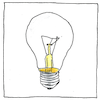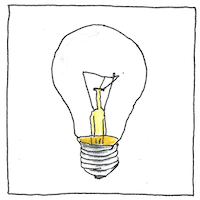Humphry Davy, Thomas Edison
physics

|
Incandescent light
Thomas Edison didn’t invent the light bulb. In 1802, Humphry Davy was the first to make an incandescent light— using a platinum strip exposed to air and powered by the Royal Society’s voltaic pile. Over two dozen scientists invented light bulbs before Edison, and improvements to the technology continued after Edison. But in 1879 Edison created an economical, long-lasting filament carbonized bamboo fiber, and created an electric distribution system to provide direct current for the lights.
Prior art
Alessandro Volta was the first person to notice that electricity could heat a copper wire until it glowed. Humphry Davy deliberately tried to make a light, using a strip of platinum for its high melting point, and leaving the metal exposed to air, but it wasn’t bright nor durable enough. Humphry Davy was also the first person to make an arc lamp, in 1809, using carbon electrodes. James Bowman Lindsay demonstrated an incandescent light in 1835, but he wasn’t interested in developing or selling it. In 1839, Marcellin Jobard suggested that mines could be illuminated by running an electric current through a carbon filament in a vacuum. Warren De la Rue enclosed a platinum coil in a vacuum tube in 1840, but the design was abandoned because of the cost of platinum. The next year, 1841, Frederick de Moleyns got a patent for the same thing, a platinum wire in a vacuum bulb. In 1845, John Wellington Starr patented two incandescent lights, one with a platinum strip in an unvacuated bulb, and another with a carbon filament in a vacuum bulb, but the next year he died of tuberculosis. In 1851, the magician Jean Eugène Robert-Houdin demonstrated incandescent lights at his estate. In 1856, Charles de Changy carried a flashlight into the mines consisting of a platinum filament burning in the open air. De Changy abandoned his work after he was criticized for trying to protect his invention from public disclosure before he could patent it. In 1860, Joseph Swan had working incandescent lamps using carbonized paper filaments in bulbs with a partial vacuum. Because of the short lifetime for these lamps, Swan renewed his effort in 1875, and by 1879 demonstrated a lamp using a carbon rod from an arc lamp in a high vacuum whose low resistance needed large wires, so was not commercially practical. In 1872, Alexander Lodygin invented an incandescent light using carbon rods in a nitrogen-filled bulb, and Lodygin’s light bulb using a molybdenum filament was demonstrated at the Paris Exposition of 1900. Walter Nernst invented the Nernst glower in 1897, which had a ceramic filament with a separate heater filament. In 1874, Henry Woodward and Mathew Evans patented a lamp with a thick carbon rod in a nitrogen-filled cylinder. They weren’t able to commercialize their invention, and sold the U.S. patent rights to Thomas Edison in 1879. Thomas Edison was the first to successfully commercialize incandescent light bulbs, but improvements continued. Alexander Just and Franjo Hanaman created the tungsten filament bulb in 1904. In 1913, Irving Langmuir invented the gas-filled light, which lengthened the lifetime of a tungsten bulb. General Electric employees Elmer G. Fridrich and Emmett H. Wiley proposed the halogen lamp in 1933, and GE improved it in 1959.
E26 screw
Base and socket one-inch diameter seven threads per inch became the standard for 120-volt circuits so electric toasters, for example, had to screw in, too.
Idea!
A real idea not just a better mousetrap is a light bulb drawn over a head with eyes looking up!



The E26 screw became a standard in the U.S. by 1908. The ‘E’ stands for Edison. Simplification of history involves forgetting details, a natural consequence of the perspective of time, so that it seems as though Edison invented the light bulb.
See also in The book of science:
Readings in wikipedia:
Oher readings: